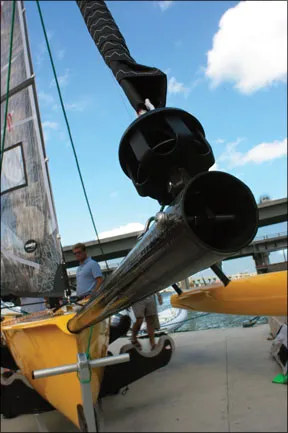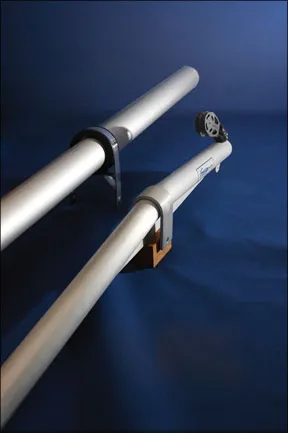
Already de rigueur with many performance-oriented sailors, easy-to-handle lightweight sails are gaining popularity with cruisers. And setting a gennaker, asymmetric spinnaker, or a new rendition of an old-fashioned drifter/reacher is easier than ever before. The big question is: Will the cost of a mini-bowsprit actually be worth the effort and expense involved?
After a series of sea trails with sprits, spinnaker socks, and free-luff furlers, weve come to the conclusion that the technology works well, but whether this is a valid investment depends on how important it is to you to keep sailing in light conditions. With fuel prices scraping the stratosphere, efficiency in light wind may be a bigger priority than it was in the past.
In our recent look at furlable code sails, drifters, gennakers, and asymmetric spinnakers (“A New Twist on Furlers,” March 2008), we proved that an efficient “no foil” furler made hoisting and dousing a large light-air sail almost a walk in the park. We also were quick to recognize that setting the sail a couple of feet ahead of the stem, on a pole, sprit, or other projection, improved both performance and the sails handling characteristics. With this in mind, we decided to delve deeper into the issue of sail-tack projection, and evaluate the differing approaches to tacking the light-air sail forward of the bow of the boat.
Much of the credit for mainstreaming this renaissance in bowsprits goes to Rod Johnstone, designer of the J-boat line and creator of the metric Js (130, 120, 105, etc.) that hit the water with a built-in, extendable free-standing pole meant to replace traditional spinnaker-handling gear. The new approach simplified foredeck gymnastics and significantly streamlined the chute-handling routine. Even so, cruisers and many racers rightfully balked at the prospect of having a big hole near the bow of their boat and a noticeable proboscis built into the topside. At the same time, shorthanded round-the-world racers were flocking to triple sets of furling headsails with light-air sails the size of circus tents set on an articulating tubular bowsprit.
This approach to sailing efficiency has now launched into the mainstream as Selden, Forespar, Forte, Sparcraft, and others have designed aftermarket kits suitable for a wide range of sailboats. All these kits have one aim: Move the tack point of any light-air sail ahead of the stem. Each design faces similar challenges, specifically the need to handle side loads on a tubular structure and the ability to adapt to a wide range of deck geometry and pre-existing obstacles.
Bowsprit engineering
In order to better understand the forces associated with modern sprit technology, a bounce or two on a playground seesaw offers some insight. On both the seesaw and the bowsprit, the location of the fulcrum and the load applied at one end of the lever arm determines what happens at the other. Its important to note both the strength and the direction of the pull when contemplating the force vectors involved. Like any lever, the longer the stress arm becomes, the more load is imposed on the fulcrum-and the stronger both the bowsprit tube and its support members must be.
Traditional bowsprits incorporated a bobstay and even whisker stays to reduce the bending loads at the fulcrum. Just as rigging turns side loads on a mast into compression loads, a bowsprits bobstay and other wires do much the same. However, many modern mini-sprits actually behave more like a free-standing mast, resisting sail loads through stiffness rather than being kept in column by a bobstay. This requires thicker or higher-modulus materials able to withstand the point load induced at the fulcrum, usually a collar-like fitting mounted on the deck.
Our furler tests revealed that close reaching with a Code 0-type sail (a specialized lightweight sail designed for sailing tighter angles than an ordinary asymmetrical spinnaker) or even the use of a more conventional light No. 1 genoa, tripled and even quadrupled the tack load. In Practical Sailors view, this sort of use mandates the need for a bobstay. Those planning to use the sprit solely for reaching purposes with an asymmetrical spinnaker or gennaker only need a bobstay if they intend to use the rig in heavy air conditions. Most manufacturers set extension length and/or wind speed limits for their sprits.
On some boats, the advantage of a sprit is offset by the amount of clutter it adds to the foredeck. Working around a windlass, bow roller, cleats, and the anchor well can turn an easy installation into a real challenge. Fortunately, these sprits come with versatile hardware kits and installation guidelines that make sense. Theres usually a need to add topping and backing plates, as well as address the concern about spreading the loads.
The installation is best handled by a pro rigger, but a skilled do-it-yourselfer should be able to handle the job. It is critical that the deck core be sealed at any new penetrations, and any new points of stress in the deck or hull are conservatively reinforced to cope with the loads of the sprit kit.
Forespar
The Forespar Banana Sprit uses a smaller-diameter sprit tube with a thick wall section, and incorporates a downward bias and a bottom gusset to add stiffness. The latest version has been extended at both the inboard and outboard ends. It the features tangs on top and bottom, which makes attaching an endless line furler and a bobstay quite simple.
When using the sprit without a furler option, the Banana Sprit leads the line aft through an optional top mounted block-as opposed to the internal tack line in the Selden sprit (see below). For added reinforcement, the manufacturer offers an optional attachment bracket along with a bobstay chainplate fitting.
Theres an upside and a downside associated with the sprits shorter length: Forward projection is limited, but the units compact size makes it very locker-stowable.
Bottom Line: Though its deck fittings and design are not as elegant as some of the others tested, it will hold favor with those who have limited space at the bow.
Forte
Based in Ledyard, Conn., Forte Carbon Fiber Products is a composite spar builder that has gained solid ground with competitive sailors. Its sprit kit package comes with nicely machined saddle-type deck fittings and webbing loops for tack attachment.

Ralph Naranjo
The diameter of carbon sprits tended to be a little larger than the alloy alternative. However, the quality of the composite tubes we looked at met an aerospace standard, and for those with extra cash to spare, the carbon sprit option is worth a second look.
Bottom Line: The weight savings of a carbon fiber sprit is significant, but so is the price increase over aluminum.
Selden
Selden makes aluminum and carbon fiber sprits. It offers three different diameter tube sections for its aluminum kits. Each comes complete with end fittings and mounting bracket options. The tack line runs through the sprit, so the outboard end acts as a guide for a tack line. The sprit also has webbing attachment points at the top and bottom.
An owner can choose either a stainless steel mounting bracket designed to fit an anchor roller, or a similar fitting designed for direct deck attachment. The well-thought-out kit includes two inboard end-clips that allow the sprit to simply be retracted and clipped for storage. In cases where an anchor locker lies beneath the sprit, the tube can be easily pulled completely free and set in a second deck ring and inboard end-clip that is set outboard near the rail.
Bottom Line: This kits combination of simple but rugged design and user-friendly installation options moved it to the top of the pack. It gets the Practical Sailor Best Choice pick.
Sparcraft
Similar to the Selden sprit, the Sparcraft system Practical Sailor evaluated is an alloy, free-standing sprit featuring a tack line through the center of the tube. The kit contains a stainless-steel mounting ring with a high molecular weight plastic sleeve insert that helps reduce chafe at the tube and the tendency for the tube to crimp. Sparcraft also offers a carbon-fiber version.
Various mounting options are available, including a temporary bobstay attachment and the ability to rig the sprit for the heavier loads imposed by a Code 0 or close-reaching in light air. The pole can be retracted for storage or removed and placed elsewhere.
Bottom Line: This sprit is very similar to the Selden, using a slightly greater tube diameter for equal-sized boats, and costing nearly double what the Selden costs.
Free standing vs. Bobstay Assist
As mentioned before, tack loads create an upward force that can be offset by a bobstay. The wire can be attached to an eye-fitting bolted through the thick solid fiberglass stem at a point well below the headstay chainplate but above the waterline. The bracket or welded tabs on the outboard end of the sprit effectively join the tack and bobstay into a single bow-string that puts compression loads on the arrow-the sprit. Hardware at the inboard end needs to be up to this compression loading. However, with a bobstay attached, some sprits can be used as a tack point for a code sail as well as for off-the-wind reaching with an asymmetric spinnaker.
With a free-standing sprit, the load at the fulcrum collar is upward, and theres a tendency to crimp the sidewall of the tube. At the inboard end of the pole, the force is downward rather than aft because theres much less compression on the sprit. Adding a bobstay causes the upward crimp load at the collar (fulcrum) to lessen, but a new compression component is introduced at the support structure located at the aft end of the pole.
Conclusion
Adding more sail to the pointy end of the boat will improve light-air performance, and the furling systems and sock technology available today make it easier than ever to manage more sail area. But it is tempting to go overboard, and add too much sail area and a too-complex system to handle it.
When all was said and done, our nod of approval went to Selden for its simple, versatile, alloy free-standing sprit, a unit thats intended for gennakers and asymmetric spinnakers. The hardware versatility makes it user-friendly, and its cost-effective price point adds to its appeal.
For those with a tight squeeze on the foredeck, Forespars Banana Sprit offers a recommended alternative. Its projection lengthprovides a sniff of clear air and a convenient tacking point for a gennaker or asymmetrical spinnaker. Forespar, does not recommend using the sprit for Code 0-type sails.
The best solution varies from crew to crew and will depend upon how much you care about performance and how much effort you’re willing to put forth to get that performance. A mini-sprit for an asymmetric or gennaker that slides forward into place and aft for easy storage will have the widest appeal. A more permanent installation with a bobstay adds light-air on-the-wind sailing capability and makes sense for those with reasonably efficient sailboats.
Carbon sprits are pricey, but the tube technology is terrific and the weight savings will probably appeal to those who go to the effort to keep neither chain nor heavy anchors stored at the bow.

































